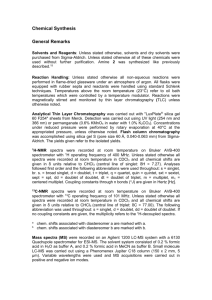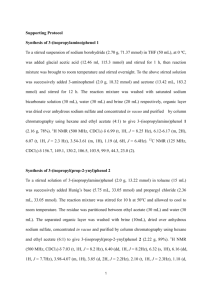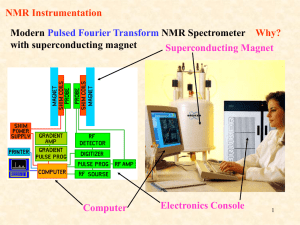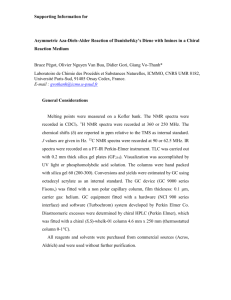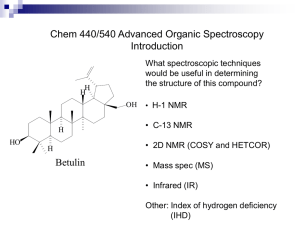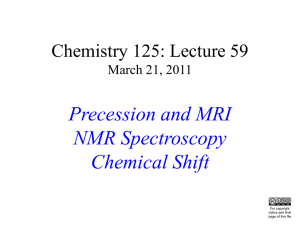Diol 2a (27 mg, 0
advertisement
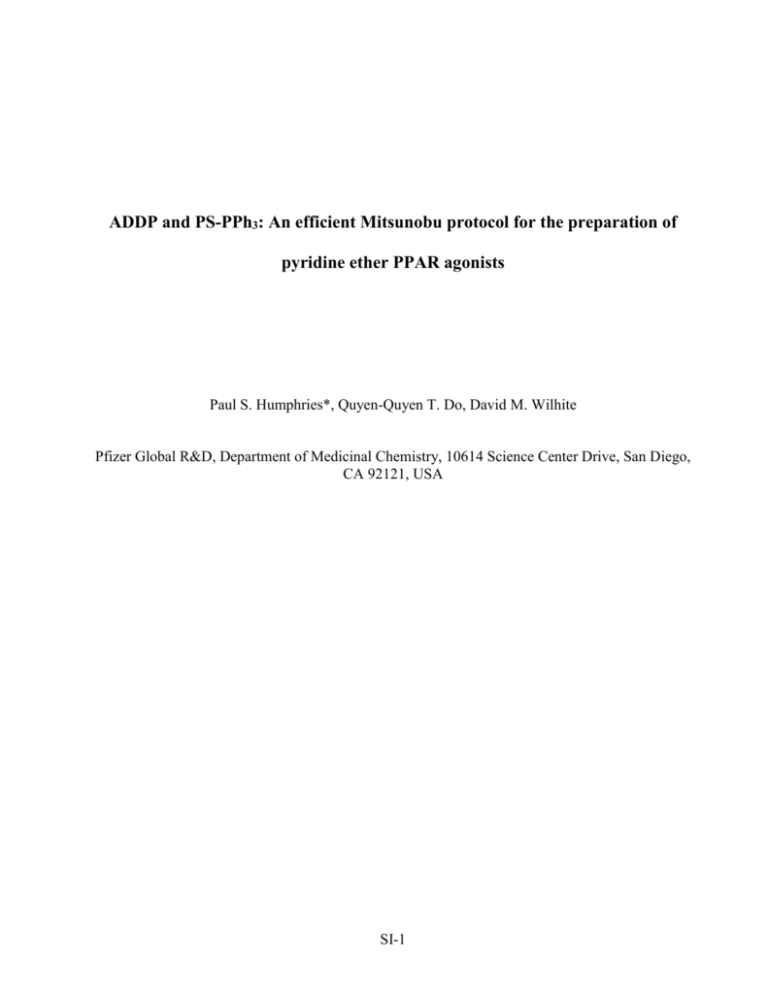
ADDP and PS-PPh3: An efficient Mitsunobu protocol for the preparation of
pyridine ether PPAR agonists
Paul S. Humphries*, Quyen-Quyen T. Do, David M. Wilhite
Pfizer Global R&D, Department of Medicinal Chemistry, 10614 Science Center Drive, San Diego,
CA 92121, USA
SI-1
Supporting Information
Proton magnetic resonance (1H NMR) spectra were determined using a Bruker Avance 300 DPX or
Bruker Avance 400 DRX spectrometer operating at a field strength of 300 or 400 megahertz (MHz).
Chemical shifts are reported in parts per million (ppm) downfield from an internal tetramethylsilane
standard. Alternatively, 1H NMR spectra were referenced to residual protic solvent signals as
follows: CHCl3 = 7.26 ppm; DMSO = 2.49 ppm; CH3OH = 3.31 ppm. Peak multiplicities are
designated as follows: s = singlet; d = doublet; dd = doublet of doublets; t = triplet; q = quartet; br
= broad resonance; and m = multiplet.
Coupling constants are given in Hertz.
Elemental
microanalyses were performed by Atlantic Microlab Inc. (Norcross, GA) and gave results for the
elements stated within ±0.4% of the theoretical values.
Flash column chromatography was
performed using Biotage disposable silica columns. Analytical thin layer chromatography (TLC)
was performed using precoated sheets of Silica 60 F254 (Merck Art 5719). Semi-preparative HPLC
samples were run on a Gilson LC3D system fitted with a 21.2 mm x 250 mm C8 column. Ramps
were optimized for each compound with a CH3CN/H2O solvent system.
All reactions were
performed in septum-sealed flasks under a slight positive pressure of nitrogen, unless otherwise
noted. All commercial reagents were used as received from their respective suppliers. Mass spectra
were measured using either electrospray (EI) or fast atom bombardment (FAB) ionization
techniques.
General procedure for the modified Mitsunobu synthesis of pyridyl ethers.
To a solution of pyridinol (0.92 mmol), alcohol (1.01 mmol) and polymer-supported
triphenylphosphine (Fluka; 3mmol/g loading) (1.38 mmol) in anhydrous tetrahydrofuran (10 mL),
under an atmosphere of nitrogen, was added a solution of 1,1’-(azodicarbonyl)dipiperidine (1.38
mmol) in anhydrous tetrahydrofuran (1 mL) dropwise. The resulting solution was stirred at ambient
temperature for 16 hours and the volatiles removed in vacuo. The residue was then purified
SI-2
(Biotage Sp4 – Hexanes to Ethyl Acetate over 10 column volumes) by silica gel chromatography to
afford the required product.
Ethyl
2-({5-[2-(5-methyl-2-phenyl-1,3-oxazol-4-yl)ethoxy]pyridin-2-yl}methyl)tetrahydro-
furan-2-carboxylate (9)
CO2Et
O
N
O
N
O
LRMS (m/z): 437 (M+H)+; 1H NMR (300 MHz, CDCl3) 8.20 (d, J=2.8 Hz, 1H), 7.99 (d, J=2.5
Hz, 1H), 7.96 (d, J=1.7 Hz, 1H), 7.70-7.64 (m, 1H), 7.49-7.39 (m, 2H), 7.19 (d, J=8.5 Hz, 1H), 7.11
(dd, J=3.0, 8.5 Hz, 1H), 4.26 (t, J=6.6 Hz, 2H), 4.17 (q, J=7.2 Hz, 2H), 3.95-3.81 (m, 2H), 3.33 (d,
J=13.8 Hz, 1H), 3.16 (d, J=13.8 Hz, 1H), 2.98 (t, J=6.6 Hz, 2H), 2.37 (s, 3H), 2.34-2.22 (m, 1H),
2.09-2.00 (m, 1H), 1.87-1.76 (m, 1H), 1.72-1.62 (m, 1H), 1.23 (t, J=7.2 Hz, 3H).
Ethyl
2-({5-[3-(5-methyl-2-phenyl-1,3-oxazol-4-yl)propoxy]pyridin-2-yl}methyl)tetrahydro-
furan-2-carboxylate (10)
CO2Et
N
O
N
O
O
LRMS (m/z): 451 (M+H)+; 1H NMR (300 MHz, CDCl3) 8.19 (d, J=2.8 Hz, 1H), 7.97-7.93 (m,
2H), 7.42-7.39 (m, 3H), 7.18 (d, J=8.5 Hz, 1H), 7.10 (dd, J=2.8, 8.5 Hz, 1H), 4.16 (q, J=7.2 Hz,
2H), 3.98 (t, J=6.0 Hz, 2H), 3.92-3.82 (m, 2H), 3.33 (d, J=13.8 Hz, 1H), 3.14 (d, J=13.9 Hz, 1H),
2.67 (t, J=6.0 Hz, 2H), 2.26 (s, 3H), 2.19-2.10 (m, 2H), 1.91-1.63 (m, 4H), 1.22 (t, J=7.2 Hz, 3H).
SI-3
Ethyl
2-({5-[2-(5-methyl-2-phenyl-1,3-thiazol-4-yl)ethoxy]pyridin-2-yl}methyl)tetrahydro-
furan-2-carboxylate (11)
CO2Et
S
N
O
N
O
LRMS (m/z): 453 (M+H)+; 1H NMR (400 MHz, CDCl3) 8.20 (d, J=2.6 Hz, 1H), 7.78-7.75 (m,
2H), 7.37-7.32 (m, 4H), 7.28 (d, J=8.6 Hz, 1H), 4.24 (t, J=6.6 Hz, 2H), 4.18 (q, J=7.1 Hz, 2H),
3.82-3.71 (m, 2H), 3.32 (d, J =13.6 Hz, 1H), 3.15 (d, J=13.6 Hz, 1H), 2.97 (t, J=6.6 Hz, 2H), 2.36
(s, 3H), 2.36-2.34 (m, 1H), 2.18-2.11 (m, 1H), 1.94-1.87 (m, 1H), 1.78-1.68 (m, 1H), 1.22 (t, J=7.2
Hz, 3H).
Ethyl
2-({5-[2-(2,5-dimethyl-1,3-thiazol-4-yl)ethoxy]pyridin-2-yl}methyl)tetrahydrofuran-2-
carboxylate (12)
CO2Et
S
N
O
N
O
LRMS (m/z): 391 (M+H)+; 1H NMR (400 MHz, CDCl3) 8.19 (dd, J=1.5, 2.0 Hz, 1H), 7.08-7.07
(m, 2H), 4.25 (t, J=6.6 Hz, 2H), 4.16 (q, J=7.0 Hz, 2H), 3.96-3.82 (m, 2H), 3.34 (d, J=3.0, 8.5 Hz,
1H), 3.17 (d, J=13.8 Hz, 1H), 2.99 (t, J=6.6 Hz, 2H), 2.58 (s, 3H), 2.38 (s, 3H), 2.35-2.23 (m, 1H),
2.10-2.01 (m, 1H), 1.88-1.77 (m, 1H), 1.73-1.63 (m, 1H), 1.21 (t, J=7.1 Hz, 3H).
Ethyl
2-[(5-{2-[2-(1,3-dimethyl-1H-pyrazol-5-yl)-5-methyl-1,3-oxazol-4-yl]ethoxy}pyridin-2-
yl)methyl]tetrahydrofuran-2-carboxylate (13)
CO2Et
O
N N
N
O
SI-4
N
O
LRMS (m/z): 455 (M+H)+; 1H NMR (400 MHz, CDCl3) 8.22 (d, J=2.6 Hz, 1H), 7.21 (d, J=8.4
Hz, 1H), 7.13 (dd, J=2.8, 8.4 Hz, 1H), 6.48 (s, 1H), 4.28 (t, J=6.5 Hz, 2H), 4.19 (q, J=7.1 Hz, 2H),
4.15 (s, 3H), 3.97-3.83 (m, 2H), 3.33 (d, J=13.6 Hz, 1H), 3.18 (d, J=13.6 Hz, 1H), 3.00 (t, J=6.5 Hz,
2H), 2.39 (s, 3H), 2.36-2.24 (m, 1H), 2.27 (s, 3H), 2.11-2.02 (m, 1H), 1.89-1.78 (m, 1H), 1.74-1.64
(m, 1H), 1.25 (t, J=7.1 Hz, 3H).
Ethyl 2-[(5-{2-[5-methyl-2-(4-methylphenyl)-1,3-oxazol-4-yl]ethoxy}pyridin-2-yl)methyl]tetrahydrofuran-2-carboxylate (14)
CO2Et
O
N
O
N
O
LRMS (m/z): 451 (M+H)+; 1H NMR (400 MHz, CDCl3) 8.07 (d, J=2.8 Hz, 1H), 7.79 (d, J=8.1
Hz, 2H), 7.38 (d, J=8.1 Hz, 2H), 7.34 (dd, J=3.0, 8.6 Hz, 1H), 7.28 (d, J=8.8 Hz, 1H), 4.40 (t, J=6.2
Hz, 2H), 4.16 (q, J=7.2 Hz, 2H), 3.91-3.85 (m, 2H), 3.49 (d, J=14.3 Hz, 1H), 3.14 (d, J=14.3 Hz,
1H), 3.04 (t, J=6.2 Hz, 2H), 2.35 (s, 3H), 2.31 (s, 3H), 2.30-2.22 (m, 1H), 1.99-1.91 (m, 1H), 1.881.72 (m, 2H), 1.22 (t, J=7.2 Hz, 3H).
Ethyl 2-[(5-{2-[5-methyl-2-(3-methylphenyl)-1,3-oxazol-4-yl]ethoxy}pyridin-2-yl)methyl]tetrahydrofuran-2-carboxylate (15)
CO2Et
O
N
O
N
O
LRMS (m/z): 451 (M+H)+; 1H NMR (400 MHz, CD3OD) 8.37 (d, J=2.6 Hz, 1H), 8.07 (dd, J=2.6,
8.9 Hz, 1H), 7.93-7.90 (m, 2H), 7.79 (d, J=8.9 Hz, 1H), 7.47-7.40 (m, 2H), 4.41 (t, J=6.2 Hz, 2H),
4.17 (q, J=7.2 Hz, 2H), 3.92-3.86 (m, 2H), 3.50 (d, J=14.3 Hz, 1H), 3.15 (d, J=14.3 Hz, 1H), 3.05
SI-5
(t, J=6.2 Hz, 2H), 2.36 (s, 3H), 2.34 (s, 3H), 2.31-2.23 (m, 1H), 2.00-1.92 (m, 1H), 1.89-1.73 (m,
2H), 1.23 (t, J=7.2 Hz, 3H).
Ethyl 2-[(5-{2-[2-(4-chlorophenyl)-5-methyl-1,3-oxazol-4-yl]ethoxy}pyridin-2-yl)methyl]tetrahydrofuran-2-carboxylate (16)
CO2Et
O
Cl
N
O
N
O
LRMS (m/z): 471 (M+H)+; 1H NMR (400 MHz, CDCl3) 8.04 (d, J=2.8 Hz, 1H), 7.85-7.83 (m,
2H), 7.41-7.39 (m, 2H), 7.33 (dd, J=3.0, 8.6 Hz, 1H), 7.27 (d, J=8.8 Hz, 1H), 4.23 (t, J=6.3 Hz,
2H), 4.14 (q, J=7.2 Hz, 2H), 3.82-3.70 (m, 2H), 3.17-3.15 (m, 1H), 3.03 (d, J=14.2 Hz, 1H), 2.91 (t,
J=6.3 Hz, 2H), 2.29 (s, 3H), 2.19-2.12 (m, 1H), 1.96-1.88 (m, 1H), 1.78-1.71 (m, 1H), 1.61-1.54 (m,
1H), 1.22 (t, J=7.2 Hz, 3H).
Ethyl 2-[(5-{2-[2-(3-chlorophenyl)-5-methyl-1,3-oxazol-4-yl]ethoxy}pyridin-2-yl)methyl]tetrahydrofuran-2-carboxylate (17)
CO2Et
O
N
O
N
O
Cl
LRMS (m/z): 471 (M+H)+; 1H NMR (400 MHz, CDCl3) 8.04 (d, J=2.8 Hz, 1H), 7.96 (s, 1H),
7.86-7.83 (m, 1H), 7.39-7.36 (m, 2H), 7.33 (dd, J=3.0, 8.6 Hz, 1H), 7.27 (d, J=8.8 Hz, 1H), 4.23 (t,
J=6.3 Hz, 2H), 4.14 (q, J=7.2 Hz, 2H), 3.82-3.70 (m, 2H), 3.17-3.15 (m, 1H), 3.03 (d, J=14.2 Hz,
1H), 2.91 (t, J=6.3 Hz, 2H), 2.29 (s, 3H), 2.19-2.12 (m, 1H), 1.96-1.88 (m, 1H), 1.78-1.71 (m, 1H),
1.61-1.54 (m, 1H), 1.22 (t, J=7.2 Hz, 3H).
SI-6
Ethyl
2-[(5-{2-[2-(4-methoxyphenyl)-5-methyl-1,3-oxazol-4-yl]ethoxy}pyridin-2-yl)methyl]-
tetrahydrofuran-2-carboxylate (18)
CO2Et
O
O
N
O
N
O
LRMS (m/z): 467 (M+H)+; 1H NMR (400 MHz, CD3OD) 8.01 (d, J=1.5 Hz, 1H), 7.80-7.77 (m,
2H), 7.25-7.24 (m, 2H,), 6.93-6.91 (m, 2H), 4.20 (t, J=6.3 Hz, 2H), 4.17 (q, J=7.2 Hz, 2H), 3.803.69 (m, 2H), 3.75 (s, 3H), 3.17-3.15 (m, 1H), 3.01 (d, J=13.9 Hz, 1H), 2.88 (t, J=6.3 Hz, 2H), 2.26
(s, 3H), 2.17-2.11 (m, 1H), 1.94-1.87 (m, 1H), 1.75-1.66 (m, 1H), 1.58-1.49 (m, 1H), 1.24 (t, J=7.2
Hz, 3H).
Ethyl
2-[(5-{2-[2-(3-methoxyphenyl)-5-methyl-1,3-oxazol-4-yl]ethoxy}pyridin-2-yl)methyl]-
tetrahydrofuran-2-carboxylate (19)
CO2Et
O
N
O
N
O
O
LRMS (m/z): 467 (M+H)+; 1H NMR (400 MHz, CD3OD) 8.01 (d, J=2.3 Hz, 1H), 7.44-7.40 (m,
2H), 7.30-7.22 (m, 3H), 6.94-6.91 (m, 1H), 4.21 (t, J=6.4 Hz, 2H), 4.16 (q, J=7.2 Hz, 2H), 3.803.67 (m, 2H), 3.75 (s, 3H), 3.21-3.17 (m, 1H), 3.01 (d, J=13.9 Hz, 1H), 2.90 (t, J=6.4 Hz, 2H), 2.28
(s, 3H), 2.17-2.11 (m, 1H), 1.94-1.87 (m, 1H), 1.77-1.67 (m, 1H), 1.60-1.50 (m, 1H), 1.22 (t, J=7.2
Hz, 3H).
Ethyl
2-{[5-(2-{5-methyl-2-[4-(trifluoromethyl)phenyl]-1,3-oxazol-4-yl}ethoxy)pyridin-2-
yl]methyl}tetrahydrofuran-2-carboxylate (20)
F
O
F
N
CO2Et
F
O
SI-7
N
O
LRMS (m/z): 505 (M+H)+; 1H NMR (400 MHz, CDCl3) 8.05 (d, J=2.8 Hz, 1H), 8.00 (d, J=8.1
Hz, 2H), 7.70 (d, J=8.3 Hz, 2H), 7.33 (dd, J=3.0, 8.6 Hz, 1H), 7.27 (d, J=8.8 Hz, 1H), 4.23 (t, J=6.3
Hz, 2H), 4.14 (q, J=7.2 Hz, 2H), 3.82-3.70 (m, 2H), 3.17-3.15 (m, 1H), 3.03 (d, J=14.2 Hz, 1H),
2.91 (t, J=6.3 Hz, 2H), 2.29 (s, 3H), 2.19-2.12 (m, 1H), 1.96-1.88 (m, 1H), 1.78-1.71 (m, 1H), 1.611.54 (m, 1H), 1.22 (t, J=7.2 Hz, 3H).
Ethyl
2-ethoxy-3-{5-[2-(5-methyl-2-phenyl-1,3-oxazol-4-yl)ethoxy]pyridin-2-yl}propanoate
(21)
CO2Et
O
N
O
N
O
LRMS (m/z): 425 (M+H)+; 1H NMR (400 MHz, CDCl3) 8.20 (dd, J=1.5, 2.0 Hz, 1H), 7.95 (dd,
J=1.9, 7.7 Hz, 2H), 7.43-7.36 (m, 3H), 7.10 (d, J=1.5 Hz, 2H), 4.25 (t, J=6.6 Hz, 2H), 4.23-4.13 (m,
3H), 3.63-3.55 (m, 1H), 3.37-3.27 (m, 1H), 3.15-3.02 (m, 2H), 2.97 (t, J=6.7 Hz, 2H), 2.35 (s, 3H),
1.21 (t, J=7.2 Hz, 3H), 1.08 (t, J=7.1 Hz, 3H).
Methyl
2-methoxy-2-methyl-3-{5-[2-(5-methyl-2-phenyl-1,3-oxazol-4-yl)ethoxy]pyridin-2-
yl}propanoate (22)
CO2Me
O
N
O
N
O
LRMS (m/z): 411 (M+H)+; 1H NMR (400 MHz, CDCl3) 8.18 (dd, J=1.3, 2.3 Hz, 1H), 7.96 (dd,
J=2.0, 7.6 Hz, 2H), 7.54-7.51 (m, 3H), 7.10-7.08 (m, 2H), 4.25 (t, J=6.7 Hz, 2H), 3.29 (s, 3H), 3.15
(s, 2H), 2.96 (t, J=6.7 Hz, 2H), 2.36 (s, 3H), 2.32 (s, 3H), 1.38 (s, 3H).
SI-8
Methyl 2-methoxy-3-{5-[2-(5-methyl-2-phenyl-1,3-oxazol-4-yl)ethoxy]pyridin-2-yl}propanoate
(23)
CO2Me
O
N
O
N
O
LRMS (m/z): 397 (M+H)+; 1H NMR (400 MHz, DMSO-d6) 8.19 (d, J=2.0 Hz, 1H), 7.94 (dd,
J=1.9, 7.7 Hz, 2H), 7.42-7.35 (m, 3H), 7.09 (d, J=1.5 Hz, 2H), 4.44 (t, J=6.8 Hz, 2H), 3.88 (dd,
J=4.8, 7.6 Hz, 1H), 3.22 (s, 3H), 2.92-2.87 (m, 3H), 2.80 (dd, J=7.8, 14.2 Hz, 1H), 2.32 (s, 3H),
1.38 (s, 3H).
Ethyl 2-({5-[2-(5-methyl-2-phenyl-1,3-oxazol-4-yl)ethoxy]pyridin-2-yl}methyl)tetrahydro-2Hpyran-2-carboxylate (24)
O
N
O
N
CO2Et
O
LRMS (m/z): 451 (M+H)+; 1H NMR (400 MHz, CDCl3) 8.17 (d, J=2.3 Hz, 1H), 7.96 (dd, J=1.9,
7.7 Hz, 2H), 7.43-7.38 (m, 3H), 7.12 (d, J=8.1 Hz, 1H), 7.09 (dd, J=2.8, 8.6 Hz, 1H), 4.24 (t, J=6.7
Hz, 2H), 4.15 (q, J=7.2 Hz, 2H), 3.88-3.84 (m, 1H), 3.64 (dt, J=3.3, 11.6 Hz, 1H), 3.07 (s, 2H), 2.96
(t, J=6.6 Hz, 2H), 2.36 (s, 3H), 2.22-2.18 (m, 1H), 1.52-1.36 (m, 5H), 1.20 (t, J=7.1 Hz, 3H).
General procedure for the microwave-assisted hydrolysis reaction.
A Smith Process Vial (2-5 mL) was charged, under nitrogen, with a stir bar, ester (0.5 mmol), 1N
aq. sodium hydroxide (1.5 mmol) and acetonitrile (2 mL). The reaction vessel was sealed and
heated at 100 oC for 10 mins (fixed hold time) in a Biotage Emrys Creator. After cooling, the vessel
was uncapped and the reaction mixture acidified to pH 5-7 with 1N aq. hydrochloric acid. The
resulting mixture was extracted with ethyl acetate (3 x 15mL) and the combined organic extracts
SI-9
dried (anhydrous magnesium sulfate), filtered and concentrated in vacuo. Purification (Biotage Sp4
– Ethyl Acetate to 50% Methanol/Ethyl Acetate over 10 column volumes) by silica gel
chromatography afforded the required product.
2-({5-[2-(5-Methyl-2-phenyl-1,3-oxazol-4-yl)ethoxy]pyridin-2-yl}methyl)tetrahydrofuran-2carboxylic acid (25)
CO2H
O
N
O
N
O
LRMS (m/z): 408 (M+H)+; 1H NMR (400 MHz, CD3OD) 8.37 (d, J=2.6 Hz, 1H), 8.07 (dd, J=2.6,
8.9 Hz, 1H), 7.93-7.90 (m, 2H), 7.79 (d, J=8.9 Hz, 1H), 7.47-7.40 (m, 3H), 4.41 (t, J=6.2 Hz, 2H),
3.92-3.86 (m, 2H), 3.50 (d, J=14.3 Hz, 1H), 3.15 (d, J=14.3 Hz, 1H), 3.05 (t, J=6.2 Hz, 2H), 2.36 (s,
3H), 2.31-2.23 (m, 1H), 2.00-1.92 (m, 1H), 1.89-1.73 (m, 2H); Anal. Calcd. For C23H25N2O5Cl: C,
62.09; H, 5.66; N, 6.30. Found: C, 61.96; H, 5.75; N, 6.18.
SI-10
